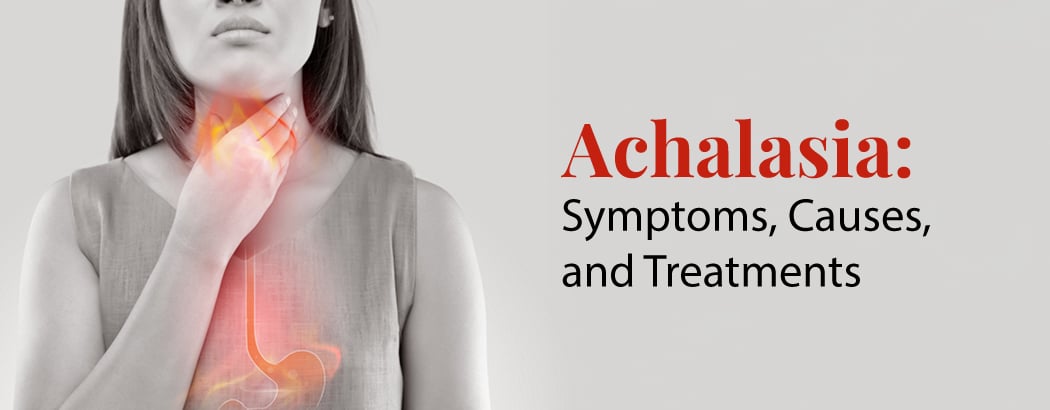Achalasia: Symptoms, causes, and treatment
May 30, 2024

Overview
The oesophagus, which is the tube that transports food from the neck to the stomach, is impacted by the uncommon but dangerous achalasia syndrome.
In achalasia, the LES (lower esophageal sphincter) does not relax during swallowing. The majority of the time, this muscular ring blocks the passage of food down through the oesophagus from the stomach, but it opens during the process of swallowing. Food may reflux back up into the oesophagus if it doesn’t open up.
This condition’s symptoms usually start slowly and might worsen with time. Food and liquid swallowing may eventually become challenging, although therapy can assist.
Contents
What is Achalasia?
Achalasia is a disorder of swallowing that affects the esophagus, the tube that runs from the mouth to the stomach. Food and liquids make it difficult for the esophageal muscles to push into the stomach due to damaged nerves. After that, food builds up in the oesophagus, where it occasionally ferments and flows back up into the mouth and is bitter. Achalasia is a rather uncommon disorder. It is sometimes misdiagnosed as gastroesophageal reflux disease (GERD). However, with achalasia, the food comes from the esophagus and in GERD, the material originates from the stomach.
There is no cure for achalasia symptoms. When the oesophagus is injured, the muscles cannot function correctly again. However, endoscopy, minimally invasive treatment, or surgery may typically be used to control symptoms of achalasia.
Symptoms of Achalasia
Most of the time, the symptoms of achalasia develop gradually and get worse with time. Among the warning signs and symptoms are:
- Dysphagia, is the most prevalent presenting characteristic. Solids are more impacted by this than liquids or soft foods
- 80–90% of patients may have regurgitation
- Chest soreness or discomfort that affects 25–50% of people. It is referred to as retrosternal and happens after eating
- Heartburn is a common condition that therapy may make worse
- Dry mouth
- Dry eyes
- Severe soreness or discomfort following a meal
- A decrease in weight may indicate cancer (may co-exist)
- One sign of the condition later on is nocturnal cough, which can even include breathing in refluxed material
Causes of Achalasia
Although the precise etiology of achalasia is unknown, many experts think a mix of variables, such as:
- Genetics or family history
- An autoimmune disease, in which the immune system of your body unintentionally targets healthy cells. The advanced symptoms of achalasia are frequently attributed to the degeneration of nerves in the oesophagus.
- Harm to the LES or esophageal nerves
- There is a theory that viral infections may trigger autoimmune reactions, particularly in those with a higher genetic susceptibility to the disorder
- Achalasia has also been connected to the occurrence of Chagas disease, an uncommon parasitic illness that mostly affects individuals in Mexico, South America, and Central America
Achalasia Treatment
Even though achalasia has no known cure, there are several therapy alternatives that can help individuals manage their symptoms and live better.
- Modifications in Lifestyle: Changing one’s way of life can be very important for controlling achalasia. These include digesting food properly, eating smaller, more often meals, and avoiding items that make achalasia symptoms worse, such as hot or fatty foods. It’s also advised to avoid lying down right away after eating and to raise the head of the bed while you sleep.
- Medications: To facilitate better swallowing and assist relax the esophageal muscles, medication may also be recommended. Lower esophageal sphincter pressure is often achieved by the use of calcium channel blockers. While headaches, lightheadedness, and flushing are possible adverse effects, these drugs can help reduce achalasia symptoms.
- Surgical Intervention: When medication and lifestyle changes are not enough to relieve symptoms, surgical treatments are frequently taken into consideration. A deflated balloon is placed into the oesophagus and subsequently inflated to extend the constricted region during balloon dilation, a minimally invasive treatment. This widens the oesophagus, which gives relief from difficulty in swallowing. Although balloon dilation can offer relief right away, the results might not last long and more than one surgery might be required.
- Myotomy: A myotomy is an additional surgical procedure that includes severing the lower esophageal sphincter’s muscles to facilitate the passage of food and liquids into the stomach. Both laparoscopic and open surgery are options for this. While a myotomy can help with swallowing function, there is a risk of developing gastroesophageal reflux disease (GERD) because the lower esophageal sphincter’s capacity to stop stomach acid from flowing back into the oesophagus is compromised.
To sum up, achalasia can be treated with medication, lifestyle changes, and surgical procedures including myotomy and balloon dilatation. Every achalasia treatment strategy has advantages and disadvantages, and the best course of action is determined by the intensity of the patient’s symptoms, personal characteristics, and the healthcare provider’s experience. To choose the best course of action for their rare condition patients should talk through these alternatives with their medical team.
Conclusion
With only one case occurring in every 100,000 persons, achalasia is regarded as an uncommon illness. Although it may happen at any age, individuals between the ages of 25 and 60 are the ones who are diagnosed with it the most frequently. Although the precise etiology of achalasia is unknown, nerve degeneration in the oesophagus is thought to play a role.
Achalasia can have a big influence on day-to-day living. Malnutrition, dehydration, and weight loss may result from swallowing difficulties. Chest discomfort, regurgitation of undigested food, and a persistent sense of heaviness are possible symptoms for patients. In addition to limiting the opportunity to enjoy meals with family and friends, the illness may also result in social and emotional distress. For people with achalasia, controlling their symptoms and enhancing their quality of life depends heavily on an early diagnosis and suitable therapy.
Frequently Asked Questions
1. If achalasia is left untreated, what are the long-term consequences?
Achalasia can cause consequences such as aspiration pneumonia, weight loss, and esophageal dilatation if it is not addressed. Getting medical help is crucial for effective management.
2. Which age group of people are more affected by achalasia?
While achalasia can affect persons of any age, it most commonly affects those who are between the ages of 25 and 60.
3. What problems might arise from achalasia?
Food that has backed up (regurgitated) into your oesophagus and subsequently been sucked into (aspirated) your trachea (windpipe), which connects to your lungs, might cause certain issues with achalasia. Among these consequences are:
- Pneumonia
- Infections of the lungs (pulmonary infections)
- Other complications include esophageal carcinoma. This malignancy is more likely to affect you if you have achalasia.







